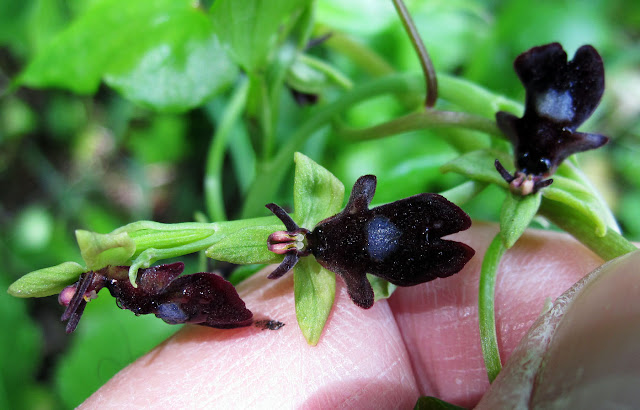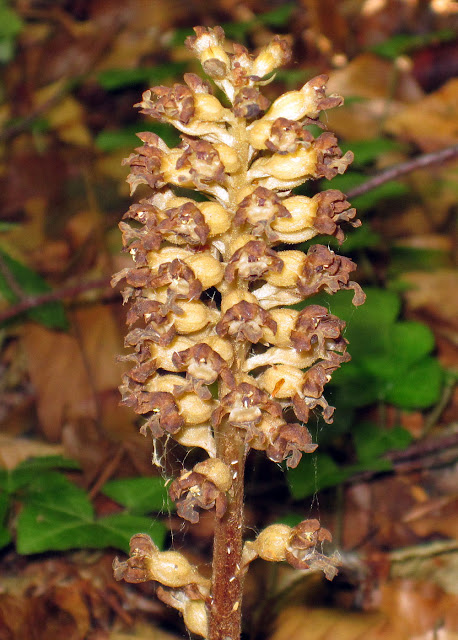 |
| Pyramidal orchid, Anacamptis pyramidalis, in bud. High Elms Country Park, 9 June 2011. |
We were looking for English orchids. They are all small, some in spikes and some with strands of flowers; nothing like the huge exotic things you can find in florists and garden centres. So if these were stunted, we would not see much at all.
In fact I had seen some quite lush common spotted orchids only a few days ago, during a dragonfly walk with the Orpington Field Club, in part of High Elms with some tree shade that has not been as dry as elsewhere. But we would not be looking there for the scarcer species.
Rain had been forecast, so I took my Ixus 100, but not my big and vulnerable camera. It's easy to find wonderful photos of orchids elsewhere; this is just a record of what I saw on this day, Thursday 9th June. As it happened, there was no rain ...
| Bee orchid, Ophrys apifera. High Elms Country Park, 9 June 2011. |
Along the hillside is Orchid Bank, a small fenced chalk meadow. Before we entered, we looked round a grassy area outside. It was woodland not too long ago, and even though it has been cleared, there are still some woodland plants there, like dog's mercury. But there are also true meadow plants, like milkwort, lesser stitchwort, bird's-foot trefoil, and wild strawberry. Bright green beetles, Chrysolina menthastri, were mating in the flowers of rough hawksbit that were everywhere among the grass.
Among these wild plants and in the grassy verges we began to find some more interesting orchids. First, a fly orchid, and then almost immediately a bee orchid. These have only a few flowers on each stem, and they are named after the insects they imitate and try to lure to accomplish their pollination.
 |
| Man orchid, Orchis anthropophorum. High Elms Country Park, 9 June 2011. |
Walking through and around the Orchid Bank, we saw several more orchids as well as more of those we'd seen already. Some broad-leaved helleborines, still growing; many twayblades in flower, quite inconspicuous with their pale green spikes. Then one of the group spotted a few man orchids, which caused great excitement.
The ribbons dangling from each flower of the man orchid have "arms" and "legs" which are said to resemble a human figure. In this photo you can see the legs clearly, but you have to look carefully to see some of the arms.
I was also interested to see the white, bell-shaped flowers of bladder campion. It was one of the many plants I am seeing this year which I have never seen before. I also saw a lot of black bryony, winding around the other plants like a bindweed, but with tiny yellowish flowers. It will have showy red berries later on.
We moved on through the woods and saw some bird's-nest orchids. These are oddities even among the orchids. They lack all chlorophyll and live off nutrients obtained from a host plant through a fungal partner. This kind of parasitical existence is not unique; there is some toothwort in these woods that has a similar mode of life. I saw some during the spring walk through these woods, and also in Cudham Valley earlier on.
That made ten orchid species, including some very nice specimens. So despite Terry's forebodings we did very well, and I was pleased to learn some new plants. I would not have spotted some of these if I had been alone, even if I had known where to look, because they were so unfamiliar. There are two other species in this locality, but the early purple orchid has flowered and gone, and no butterfly orchids have been found this year.
 |
| Common spotted orchid, Dactylorhiza fuchsii; a white-flowered example. Behind it to the right, a common twayblade, Neottia ovata. High Elms Country Park, 9 June 2011. |
 |
| Violet helleborine, Epipactus purpurata, not yet in flower. High Elms Country Park, 9 June 2011. |
 |
| Fly orchid, Ophrys insectifera, pulled sideways by black bryony. High Elms Country Park, 9 June 2011. |
 |
| Bird's-nest orchid, Neottia nidus-avis, deep in beech woodland. High Elms Country Park, 9 June 2011. |
Excellent induction. There is more to orchids than having read Rex Stout! Some of these are much more interesting to look at than florist orchids.
ReplyDeleteJust spotted an orchid up at high elms today, can a send someone a photo and ask what it is?
ReplyDeleteYou could try me at moremoth on gmail (this is a slightly disguised email address). The most likely orchid sighting at High Elms just now is leaf rosettes of Common Spotted Orchid - there are hundreds.
ReplyDelete